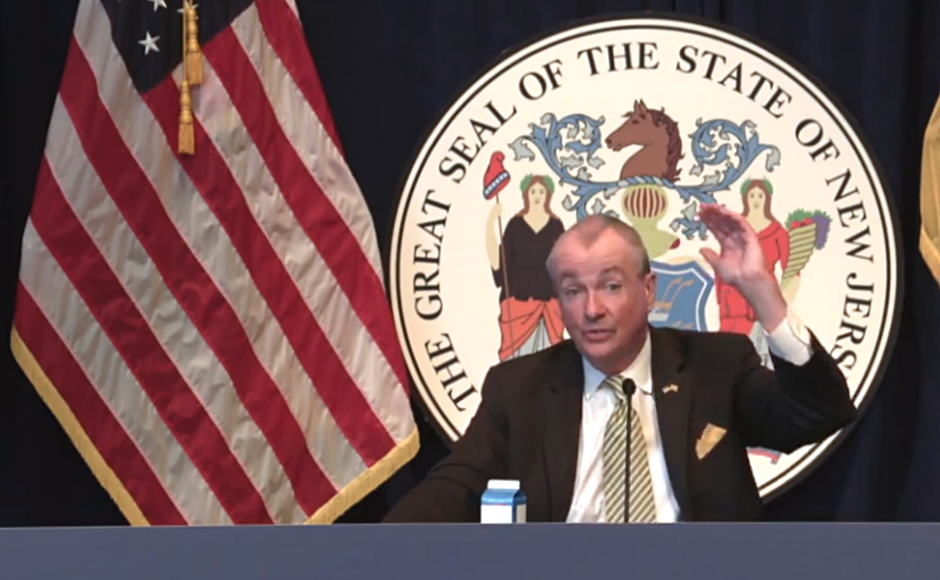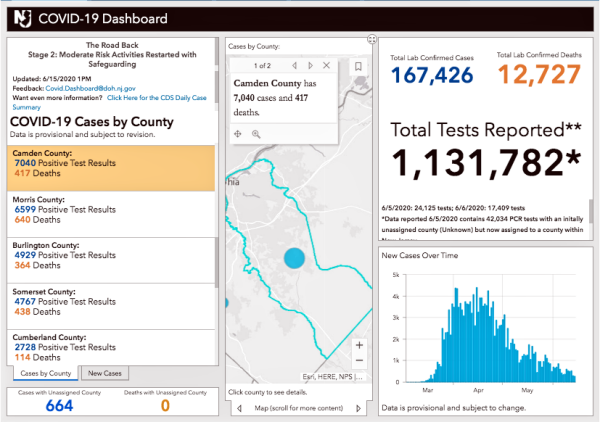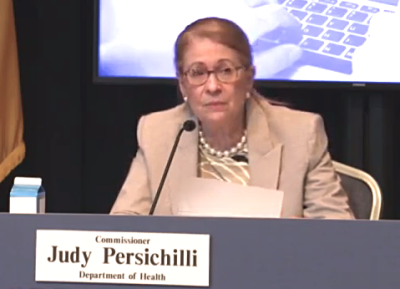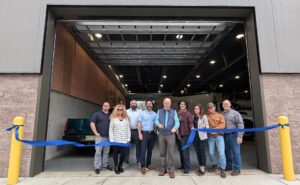Plus: New Jersey logs two more cases of pediatric multi-symptom inflammatory syndrome.
By Matt Skoufalos | June 16, 2020
Another 470 New Jersey residents have tested positive for novel coronavirus (COVID-19), bringing the statewide total to 167,426 cases, Governor Phil Murphy reported Tuesday.
Sadly, 51 more residents have perished from complications related to the virus, bringing the statewide death toll to 12,727 lives lost during the pandemic.
In all, the state has seen just 50 COVID-19-related deaths of people younger than 30, said New Jersey Health Commissioner Judy Persichilli. Nearly 80 percent of fatalities are among those 65 and older.
Throughout New Jersey, 1,291 people are hospitalized with a case of COVID-19, or while awaiting confirmation of their symptoms, another new low.
Of those 1,291 patients, 362 are in intensive or critical care; 245 of ICU and critical-care patients (68 percent) are on ventilators—the lowest percentage of patients on ventilators to date.
Overnight, 71 New Jersey hospitals admitted 33 new COVID-19 patients, and 53 others were discharged, either to a lower-acuity care setting or to their homes.
The statewide average of COVID-19 spot positivity testing stood at 2.46 percent June 11; in South Jersey, it’s more than double that, at 4.81 percent.
Rt, or the estimated rate of transmission of new cases of the virus, was 0.69 on June 14. That figure indicates that every person infected with COVID-19 is infecting fewer than one other person, on average, which means the number of new cases continues to decline.
Across New Jersey, 555 long-term care (LTC) centers have reported at least one case of COVID-19, and account for 35,403 infected patients and staff, or 21 percent of total cases.
That includes 23,580 residents and 11,823 staffers sickened by the virus, as well as 6,020 lab-confirmed resident deaths (47 percent of the statewide total) and 116 facility-reported staff deaths.
Of 654 veterans residing in a state-run home, 385 residents have tested positive for COVID-19, and 146 have died from complications related to the virus.
Seven veterans presently are hospitalized with COVID-19, and 221 have recovered from the virus.
At state-run psychiatric facilities, 211 of 1,239 patients and 492 staff members have tested positive for COVID-19. Seven staffers and 13 patients have died from complications related to the virus; unchanged since last week.
Eight patients are presently receiving care at one of the state’s field medical stations, which have served 476 people in total.
To date, 42 New Jersey children, aged 1 to 18, have been diagnosed with pediatric multisystem inflammatory syndrome, Persichilli said—two more since June 12.
All have tested positive for an active COVID-19 infection or the presence of COVID-19 antibodies, indicating exposure to the virus. Three children are still currently hospitalized. No deaths have been associated with this syndrome in New Jersey.
NJ to build wind port in Salem County
New Jersey Economic Development Authority (EDA) Chair Tim Sullivan joined Murphy’s briefing Tuesday to announce that the state will construct “the first purpose-built wind port in North America” in Lower Alloways Creek.
“This is the key to unlocking potentially thousands of jobs in manufacturing, in assembly, and operations in New Jersey,” Sullivan said.
The project could generate as much as $500 million in annual economic impact with $300 to $400 million invested in its construction and development, he said.
New Jersey has committed to generating 7.5 gigawatts (GW) of electricity through offshore wind power as part of a 25-GW pledge made by a coalition of states from the Carolinas to Maine. All told, that’s a $100-billion, 15-year investment on the eastern seaboard; New Jersey’s share could harness enough offshore wind to power 17 million homes, Sullivan said.
The 200-acre port will help build infrastructure “as tall as the Eiffel Tower” to get components out to sea upright. Sullivan said the project could create 1,500 permanent jobs in assembly and operations as well as hundreds of construction jobs starting in early 2021. It could generate as much as half a billion dollars in economic activity every year, enabling competition that can lower energy costs, and will be built with union labor and according to green design principles.
The first phase of the project will develop a 30-acre site for component manufacturing and resource marshalling; the second phase will expand to 150 more acres. EDA “is currently considering a range of public, private, and public-private partnership financing options” to cover the cost of its investment in the project, the governor said in a written statement.
Sullivan called the project “a generational opportunity” for the state, a “game-changer,” and a “a big, big win.”
“We desperately need good-paying, union jobs in places like Salem County,” Murphy said, describing the port as a piece of his clean energy infrastructure economic initiative.
Clean energy projects can help offset some negative impacts of social determinants of health, Persichilli said.
“We know that clearer air means better health,” she said. “With no change, we can expect thousands more premature deaths per year by 2050 due to declining air quality.”







